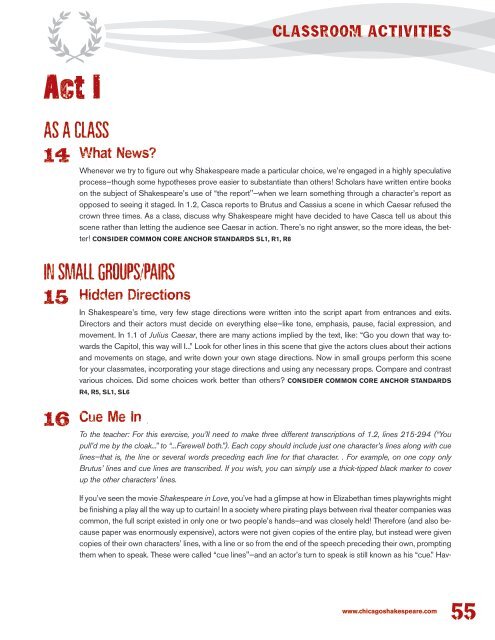Julius Caesar • 2013 - Chicago Shakespeare Theater
Julius Caesar • 2013 - Chicago Shakespeare Theater
Julius Caesar • 2013 - Chicago Shakespeare Theater
You also want an ePaper? Increase the reach of your titles
YUMPU automatically turns print PDFs into web optimized ePapers that Google loves.
Act I<br />
AS A CLASS<br />
14<br />
What News?<br />
CLASSROOM ACTIVITIES<br />
Whenever we try to figure out why <strong>Shakespeare</strong> made a particular choice, we’re engaged in a highly speculative<br />
process—though some hypotheses prove easier to substantiate than others! Scholars have written entire books<br />
on the subject of <strong>Shakespeare</strong>’s use of “the report"—when we learn something through a character’s report as<br />
opposed to seeing it staged. In 1.2, Casca reports to Brutus and Cassius a scene in which <strong>Caesar</strong> refused the<br />
crown three times. As a class, discuss why <strong>Shakespeare</strong> might have decided to have Casca tell us about this<br />
scene rather than letting the audience see <strong>Caesar</strong> in action. There’s no right answer, so the more ideas, the better!<br />
CONSIDER COMMON CORE ANCHOR STANDARDS SL1, R1, R8<br />
IN SMALL GROUPS/PAIRS<br />
15<br />
16<br />
Hidden Directions<br />
In <strong>Shakespeare</strong>’s time, very few stage directions were written into the script apart from entrances and exits.<br />
Directors and their actors must decide on everything else—like tone, emphasis, pause, facial expression, and<br />
movement. In 1.1 of <strong>Julius</strong> <strong>Caesar</strong>, there are many actions implied by the text, like: “Go you down that way towards<br />
the Capitol, this way will I...” Look for other lines in this scene that give the actors clues about their actions<br />
and movements on stage, and write down your own stage directions. Now in small groups perform this scene<br />
for your classmates, incorporating your stage directions and using any necessary props. Compare and contrast<br />
various choices. Did some choices work better than others? CONSIDER COMMON CORE ANCHOR STANDARDS<br />
R4, R5, SL1, SL6<br />
Cue Me In<br />
To the teacher: For this exercise, you’ll need to make three different transcriptions of 1.2, lines 215-294 (“You<br />
pull’d me by the cloak...” to “...Farewell both.”). Each copy should include just one character’s lines along with cue<br />
lines—that is, the line or several words preceding each line for that character. . For example, on one copy only<br />
Brutus’ lines and cue lines are transcribed. If you wish, you can simply use a thick-tipped black marker to cover<br />
up the other characters’ lines.<br />
If you’ve seen the movie <strong>Shakespeare</strong> in Love, you’ve had a glimpse at how in Elizabethan times playwrights might<br />
be finishing a play all the way up to curtain! In a society where pirating plays between rival theater companies was<br />
common, the full script existed in only one or two people’s hands—and was closely held! Therefore (and also because<br />
paper was enormously expensive), actors were not given copies of the entire play, but instead were given<br />
copies of their own characters’ lines, with a line or so from the end of the speech preceding their own, prompting<br />
them when to speak. These were called “cue lines"—and an actor’s turn to speak is still known as his “cue.” Hav-<br />
www chicagoshakespeare com 55




